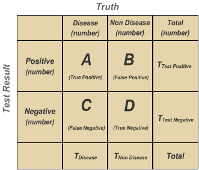- R-PAS is a direct descendant (in terms of developers, categories, scoring and research basis) of the Comprehensive System, which has been subject to peer review, revision, and updates since its first edition in 1973.
- MCMI Is a direct descendant of the Millon Clinical Multiaxial Inventory, whose first edition was in 1977.
- The WDCT (CWS) is a direct descendant of the Crisi Wartegg System which has been researched and published upon since 1983.
Relevance and error: Provides information of real value, at least indirectly, to deciding the issue in the present case.
- Must be applicable to the facts in the instant case (to population and purpose of the evaluation)
- Must not involve speculation or acceptance of one or two equally plausible scenarios
- Two types of error rates in testing hypotheses: “Type I error” and “Type II error.” Type I error (B) is the test’s propensity for false positives while Type II (C) error is the test’s propensity for false negatives.


- Sensitivity= A/(A+C) X 100 True positive (A): prob that test will identify a disorder among those w the disorder.
- Specificity=D/(B+D) X 100 True Negative (D): probability that test will not identify a disorder among those who don’t have the disorder
- Positive predictive power: A/(A+B) x 100: prob that a positive result will occur in the total population; percentage of true positives in the population.
- Negative Predictive value: D/(C+D) x 100: percentage of true negatives among test negatives
- Testability or falsifiability of the opinion or test’s basis
1) Is the proposed theory (or technique), on which the testimony is to be based, testable? If so, has it been tested?
a) Yes: All tests used by me are evidence-based; convergent and discriminant validity have been measured, as well as reliability, temporal stability, external correlates (see below on error rate)
- Reliability (here applies to R-PAS and Wartegg only):
R=PAS- Inter-rater reliability: overall Kappas are .85, and for individual responses (Meyer, Viglione and Mihura, 2017)
- R-PAS reliability data are comparable to or better than the well-established interrater reliability for the CS
- Exner presented test-retest reliability for 7 ratios and percentages, 6 had test-restest values over .75 for 1 year, while a measure of stress and distress was sw lower, expectably (,64)
- Wartegg:
- ICC’s at protocol level for inter-rater reliability: .763 – .988
- Gronnerod & Gronnerod (2012) The meta-analytic review indicates a “high average inter-scorer reliability of rw=.74 and high validity effect size for studies with clear hypotheses of rw= .33”
- Inter-rater reliability: overall Kappas are .85, and for individual responses (Meyer, Viglione and Mihura, 2017)
c. For all tests used Construct validity has been assessed: via confirmatory factor analyses, correlations with other tests with different methods, with clinical judgements and behavioral measures:
2) Has the proposed theory (or technique) been tested using valid and reliable procedures and with positive results?
Yes: All tests used provide reliable and valid procedures for administration, scoring, and analysis. All have been validated through extensive research.
Research on Test Validity positive results on tests of validation: There is a host of peer-reviewed publications, including
1) Mihura, meta-analysis of R-PAS publications. 2) A Wartegg meta-analysis;
3) Many studies of the MMPI-2 and MCMI, less so the MMPI-2 RF and MCMI-IV.
Anderson, Selbom, et.al., 2015 , the current study provided a much needed evaluation of the associations between the MMPI–2–RF and DSM–5 Section II PD diagnoses. Through the use of advanced statistical methods, we showed that scales on the MMPI–2–RF meaningfully converge with PDs and also that PDs can be measured through the use of dimensional constructs. This provides support for the use of the MMPI–2–RF in assessing and diagnosing PD’s.
- Basis of opinion subject to peer review publication:
- MMPI: extensive publications on forensic use of the MMPI, MMPI-2, and MMPI-2 RF in forensic contexts: Work of Butcher (Pope, Bucher and Seelen (The MMPI, MMPI-2 and MMPI-A in Court, 1993), Ben-Porath, Archer
- As of 2012. 2000 published articles on MMPI-2
- Rorschach research, a typical annual rate of nearly 100 articles per year (Erard, 2012)
- Meta-analysis: Mihura, Meyer, Dumitrascu, and Bombel, The Validity of Individual Rorschach Variables, Psychological Bulletin, 2013
- Wartegg: 230 peer-reviewed journal articles (Gronnerod & Gronnerod, 2012); Crisi System
- Peer-reviewed: PUBMED search for peer-reviewed articles
- MMPI-2 RF: 400 total, 351 in title
- R-PAS: 1638 total, 221 in title
- MCMI (since 2011 when MCMI-IV introduced) 358 total, 295 since 2012; 300 published articles as of 2012 on MCMI tests
- Wartegg: 16 articles in PubMed database, 34 on CWS webpage. Gronnerod and Gronnerod meta-analysis article (2012), included over 500 publications, of which 230 were peer-reviewed journal articles (plus books, book chapters, addresses at meetings).
- What is the known or potential error rate of the scientific theory or technique?
Archer etal. (2016) the error rate of the instrument… “may be expressed (as a standard error of measurement) and/or in terms of sensitivity and specificity in predicting an individual’s membership in forensically relevant groups, for example, correctly identifying individuals who do and do not have a high risk of sexual offense recidivism.”
Also reliability : Evidence of reliability… “would also include indices of situational stability across time …(e.g., test–retest reliability) as well as internal consistency measures such as alpha coefficient reliability …”